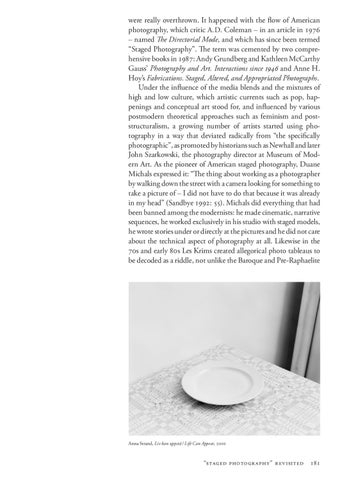were really overthrown. It happened with the flow of American photography, which critic A.D. Coleman – in an article in 1976 – named The Directorial Mode, and which has since been termed “Staged Photography”. The term was cemented by two comprehensive books in 1987: Andy Grundberg and Kathleen McCarthy Gauss’ Photography and Art. Interactions since 1946 and Anne H. Hoy’s Fabrications. Staged, Altered, and Appropriated Photographs. Under the influence of the media blends and the mixtures of high and low culture, which artistic currents such as pop, happenings and conceptual art stood for, and influenced by various postmodern theoretical approaches such as feminism and poststructuralism, a growing number of artists started using photography in a way that deviated radically from “the specifically photographic”, as promoted by historians such as Newhall and later John Szarkowski, the photography director at Museum of Modern Art. As the pioneer of American staged photography, Duane Michals expressed it: “The thing about working as a photographer by walking down the street with a camera looking for something to take a picture of – I did not have to do that because it was already in my head” (Sandbye 1992: 55). Michals did everything that had been banned among the modernists: he made cinematic, narrative sequences, he worked exclusively in his studio with staged models, he wrote stories under or directly at the pictures and he did not care about the technical aspect of photography at all. Likewise in the 70s and early 80s Les Krims created allegorical photo tableaus to be decoded as a riddle, not unlike the Baroque and Pre-Raphaelite
Anna Strand, Liv kan uppstå / Life Can Appear, 2010
“Staged Photogr aphy” R evisited 181
